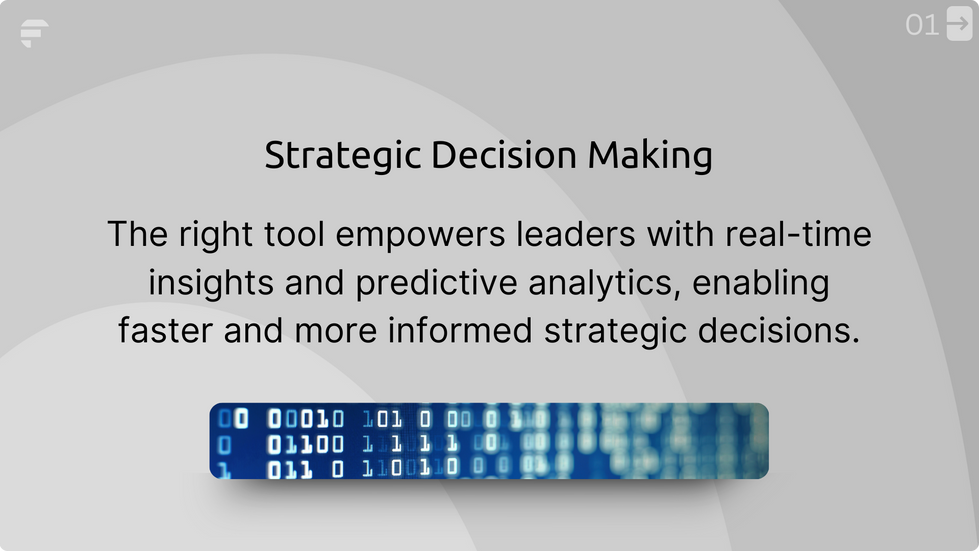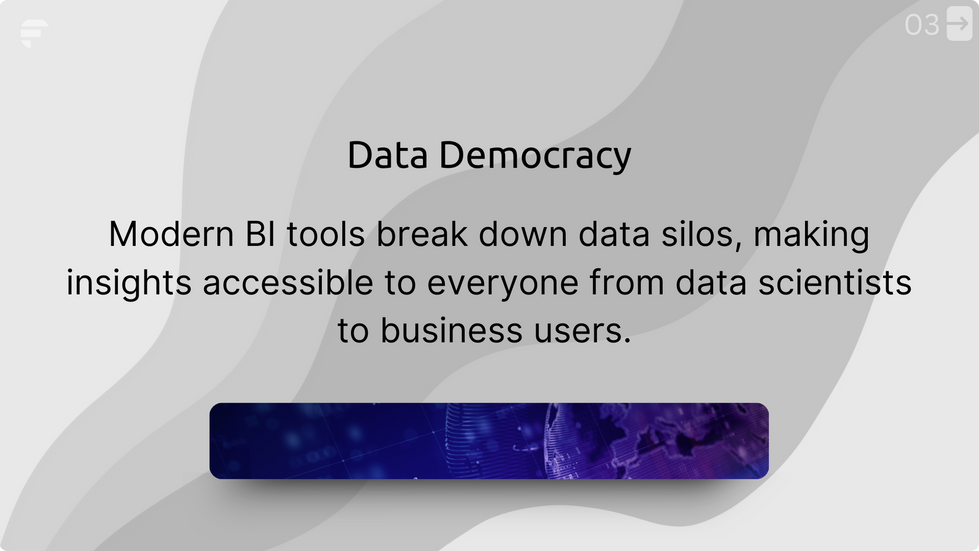Comparing Top BI Tools: Power BI, Tableau, GoodData & Qlik Sense
- Nikita Katekar
- Jan 16
- 4 min read
Author: Nikita Katekar
Consultant (Data & Analytics), Fluidata Analytics
In the vast ocean of corporate data, valuable insights float like precious pearls, waiting to be discovered. Every day, businesses generate mountains of information – from sales transactions and customer interactions to operational metrics and market trends. But without the right tools to dive deep into this ocean of data, these insights remain hidden beneath the surface.
Enter modern Business Intelligence (BI) tools – the sophisticated diving equipment of the data world. These powerful platforms combine advanced analytics, artificial intelligence, and machine learning capabilities to help organizations transform raw data into actionable insights. However, with the rapidly evolving technology landscape and numerous options available, selecting the right BI tool can feel like navigating through uncharted waters.
Here's what you'll find in this comparative article:
Understanding the Power of Business Intelligence
At its core, Business Intelligence is more than just fancy dashboards and colorful charts. It's a comprehensive approach to data analysis that enables organizations to:
Transform complex data into clear, actionable insights
Automate routine analysis and reporting tasks
Identify trends and patterns that human analysis might miss
Make data-driven decisions with confidence
Share insights across teams and departments seamlessly
A modern BI tool serves as the central nervous system of an organization's data operations. It connects various data sources, processes information, and delivers insights to stakeholders in the format they can easily understand and act upon.
Why Your Choice of BI Tool Matters
Selecting the right Business Intelligence tool is a decision that impacts every level of your organization:
I’m comparing four leading BI platforms & tools: Power BI, Tableau, GoodData, and Qlik Sense. Each brings unique strengths to the table, and understanding these differences is crucial for making an informed choice for your organization.
Let's Compare BI Tools: Power BI, Tableau, GoodData, Qlik Sense
01: Architecture and Technical Foundation
Power BI | Tableau | GoodData | Qlik Sense | |
|---|---|---|---|---|
Architecture | Not cloud-native, strong Microsoft ties | Traditional, not cloud-native | Cloud-native, Docker/Kubernetes-based | Cloud-native, open APIs |
Real-Time Analytics | Strong | Strong | Strong | Strong |
Semantic Model | Exposed | Exposed | Exposed | Composable metrics |
Multi-Tenancy | Limited | Limited | Strong | Strong |
02: Data Visualization & User Experience
Power BI | Tableau | GoodData | Qlik Sense | |
|---|---|---|---|---|
Dashboard Creation | User-friendly, self-service | Intuitive, drag-and-drop | Self-service, drag-and-drop | Self-service, associative engine |
Integration | Basic, strong Microsoft ecosystem | Basic, standalone deployments | Advanced (React, Angular, Vue) | Web components, flexible methods |
AI/ML Features | NLQ, Auto ML | Basic visual AI | NLQ, one-click ML | Predictive analytics, automation |
03: Deployment & Pricing
Power BI | Tableau | GoodData | Qlik Sense | |
Deployment Options | Cloud-based via Azure | Cloud and on-premises | Cloud-hosted and self-hosted | Cloud and on-premises |
Pricing | Low-cost for SMBs | High upfront cost | Flexible, not per-user | Enterprise-focused |
04: Industry Suitability
Power BI | Tableau | GoodData | Qlik Sense | |
SMBs | Microsoft-centric organizations | Not ideal | Scalable, flexible pricing | Not ideal |
Enterprises | Not ideal | Visualization-focused | Flexible, AI-driven | Robust integration, analytics |
In Summary:
Power BI:
Microsoft’s business intelligence tool, integrates seamlessly with its ecosystem (Excel, Azure, Teams). It offers strong self-service analytics and real-time insights but lacks cloud-native architecture and advanced multi-tenancy. Ideal for Microsoft-centric businesses and small to medium-sized organizations due to its competitive pricing.
Tableau:
Tableau is a leading data visualization tool known for its intuitive drag-and-drop interface and extensive visual options. It supports both cloud and on-premises deployments, making it flexible for large enterprises. However, it lacks advanced cloud-native features and multi-tenancy support, positioning it as ideal for visualization-focused enterprises.
GoodData:
GoodData is a cloud-native analytics platform built on Docker and Kubernetes, offering high-performance analytics and strong multi-tenancy support. It excels with flexible deployment, advanced AI/ML features, and a unique pricing model not based on per-user licensing. Ideal for scalable, cloud-first businesses or SaaS providers.
Qlik Sense:
Qlik Sense is a cloud-native analytics platform with strong multi-tenancy support and unique associative analytics. It offers advanced AI/ML capabilities, real-time insights, and flexibility with open APIs and composable metrics. Best suited for large enterprises with complex data integration and analytics needs.
Making the Right Choice: Comparing Beyond Features
As we've explored the capabilities of Power BI, Tableau, Qlik Sense, and GoodData, one thing becomes crystal clear: there's no one-size-fits-all solution in the Business Intelligence landscape. Each platform, like a finely crafted instrument, plays its own unique role in the orchestra of data analytics.
Understanding Your Data Symphony
Think of choosing a BI tool as selecting a conductor for your data symphony:
Power BI orchestrates seamless performances within the Microsoft ecosystem
Tableau creates visual masterpieces that tell compelling data stories
Qlik Sense composes innovative analytical harmonies with its associative engine
GoodData arranges cloud-native concertos with scalable precision
The Path Forward
Before making your final decision, consider these critical factors:
Current and Future Needs
Where is your organization today?
Where do you want to be in 3-5 years?
What scale of data growth do you anticipate?
User Orchestra
Who are your primary data consumers?
What level of technical expertise exists in your team?
How much training resources can you allocate?
Integration Landscape
What systems need to communicate with your BI tool?
How complex are your data sources?
What security requirements must be met?
Resource Reality
What is your budget not just for purchase, but for maintenance?
Do you have the necessary infrastructure?
What level of support will you need?
The Investment Perspective
Remember, choosing a BI tool isn't just a technology decision – it's a business investment. The right choice can:
Transform data from a cost center into a profit generator
Enable faster, more confident decision-making
Create a competitive advantage in your market
Foster a data-driven culture across your organization
Takeaway?
In the ocean of data we explored at the beginning of this article, your chosen BI tool will be your navigation system, diving gear, and treasure map all in one. Whether you choose the Microsoft-integrated efficiency of Power BI, the visualization prowess of Tableau, the innovative analytics of Qlik Sense, or the cloud-native flexibility of GoodData, success lies in aligning the tool's strengths with your organization's unique needs.
The best BI tool isn't necessarily the one with the most features or the highest market share – it's the one that best helps your organization turn data into decisions, insights into actions, and challenges into opportunities.
Remember: In today's data-driven world, it's not just about having access to information – it's about having the right tools to make that information work for you.
Reach out to us at hello@fluidata.co
Your journey through the data ocean awaits. Choose your vessel wisely.
















